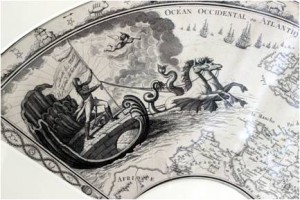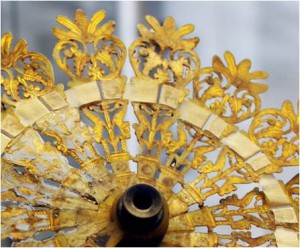 Fans are so much more than fashionable accessories: They are useful for flirting, can cool heated cheeks or hide an unladylike emotion. In the wake of the Napoleonic War, their usefulness was boosted beyond the known limit when fans were made for spying, i.e. discretely observing the surrounding or other persons. I found some examples of these extraordinary devices when I visited the exhibition “Waterloo: Life & Times” of the Fan Museum in Greenwich, UK.
Fans are so much more than fashionable accessories: They are useful for flirting, can cool heated cheeks or hide an unladylike emotion. In the wake of the Napoleonic War, their usefulness was boosted beyond the known limit when fans were made for spying, i.e. discretely observing the surrounding or other persons. I found some examples of these extraordinary devices when I visited the exhibition “Waterloo: Life & Times” of the Fan Museum in Greenwich, UK.
Results for Tag: Fans
The Unrivalled Beauty of the Hand-held Fan in the Romantic Age
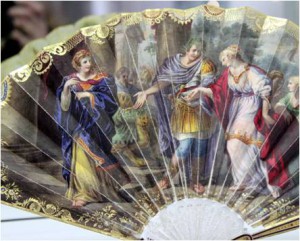 Sit back and enjoy photos of beautiful or interesting fans made between 1770 and 1815. Occasionally a plot bunny hops in, inspiring you to make use of fans in your Regency Novel.
Sit back and enjoy photos of beautiful or interesting fans made between 1770 and 1815. Occasionally a plot bunny hops in, inspiring you to make use of fans in your Regency Novel.
You can click on each photo to enlarge it. Continue reading
Sign your name across my card
How to use a dance card in the Romantic Age

For a young lady few things would be more satisfying than being a sought-after dancing partner at a glamourous ball. But if she was in constant demand, how would she keep track of the partners engaging her for the waltz or the cotillion later in the evening? And how would a gentleman secure a dance with her?
Keeping track of the gentlemen who had promised a dance in the course of the evening was done – on the Continent – with the assistance of a so called ‘carnet de bal‘ (a dance card). A gentleman would ask a lady to write down his name on the card a for a specific dance. These small and often precious carnets de bal were very popular in France and Austria throughout the 18th century.
In Britain, the dance card became fashionable at around the turn of the 18th century. The carnet de bal initially was often less elaborate than the Continental model.
Fashion for a Fashionable Item

Hand-held fans, previously reserved for royalty and aristocrats, become a must-have accessory for every lady in high society at the end of the 17th century. The trend to carry a fan spreads rapidly through society. With this, the decoration of the fan leave becomes light-hearted: The religious and classical motifs give way to pastoral scenes, al fresco parties, and themes of love-and-courtship. Interestingly, fashion itself also features on the fashionable accessories, serving as a fashion plate and fashion statement.
Continue readingUnique Fans Related to Historic Events of the 18th Century
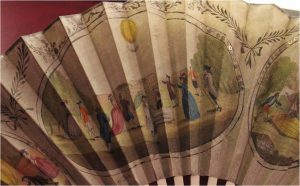 Hand-held fans of the 18th century were more than an accessory. They often commemorated political milestones, were a display of loyalty and patriotism, and celebrated popular social and scientific events.
Hand-held fans of the 18th century were more than an accessory. They often commemorated political milestones, were a display of loyalty and patriotism, and celebrated popular social and scientific events.
For this post, I have compiled 8 fans related to historic events of the 18th century for you. Enjoy the beauty and singularity of the objects, and marvel at the craftsmanship.
Fabulous Fashion Item: A Brief History of the Hand-held Fan
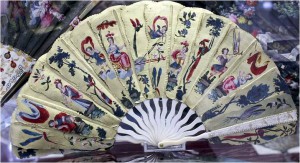
Palmette fan from 1680. The elements of the leaf are made of silk fixed on cardboards and are painted with gold and silver.
This post celebrates a fabulous fashion item: the hand-held fan.
From a ceremonial tool used in churches it developed into a must-have accessory of the high-society. Designs and materials varied with politics, social changes and fashion. Still, the fan always was an object of breathtaking beauty.
Enjoy the photos and the brief overview of the history of the fan in England. You can click on the photos to enlarge them.
A Brief History of the Napoleonic Wars told … in 10 Hand-held Fans
A fan was a popular accessory in the Romantic Age. No lady would be seen without a fan at a ball or assembly. The design of the fans was as varied as was the fashion. Often political events were celebrated or commemorated with special designs for fans. The victories of the British Army during the Peninsular Wars and the Battle of Waterloo were such occasions. It is even possible to tell a brief history of the Napoleonic Wars in 10 beautiful fans made between 1800 – 1816.

